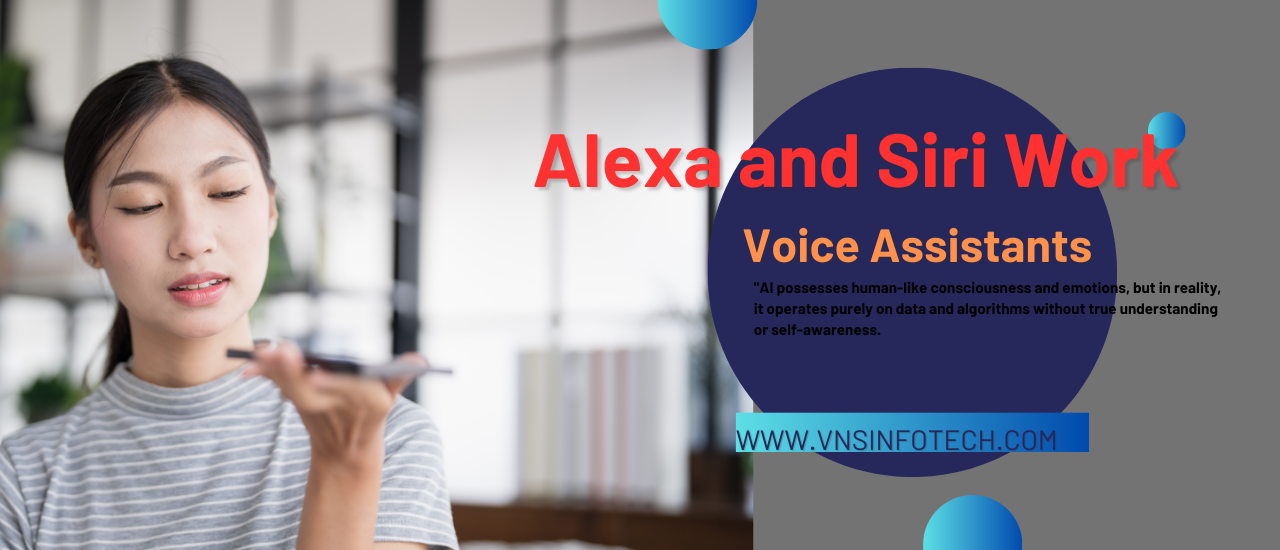Voice assistants like Amazon’s Alexa and Apple’s Siri have become an integral part of our daily lives through daily use of devices. Both of these use AI-powered systems to let users interact with their devices through voice commands. This can simplify tasks like setting reminders, searching for information or controlling smart home devices. But friends, how does a voice assistant work, how do Alexa and Siri work, let’s find out.
1. How Alexa Works
Amazon’s Alexa is a voice assistant that operates through Echo devices and other smart devices. You can see below how Alexa works:
a) Wake Word Detection
Alexa constantly listens for its wake word (“Alexa,” “Echo,” “Computer,” or “Amazon”). By detecting the wake word, the device begins recording the user’s commands.
b) NLP and Intent Recognition
Alexa’s NLP system processes text to understand the intent of a given command. If a user says, “Alexa, play music,” it identifies the main intent (play music) and the parameters (genre).
c) Voice Processing and ASR
Once the wake word is detected, the spoken command is sent to Amazon’s cloud servers, where ASR converts it into text.
d) Cloud Processing and Response Generation
Alexa accesses cloud databases, APIs, and integrated services to generate accurate responses. If a user asks about a voter, Alexa retrieves data about the voter and formulates a verbal response.
e) Text-to-Speech Conversion and Output
The final response is converted into spoken words using TTS and delivered to the user.
2. How Siri Works
Apple’s Siri is a knowledge-driven voice assistant integrated into iPhones, iPads, Macs, and HomePods. How Siri processes commands such as:
a) Wake Word Activation
Siri is activated when the user says “Hey Siri” or presses a designated button. Newer Apple devices use on-device AI to efficiently detect wake words.
b) On-Device Processing vs. Cloud Processing
- On-device processing: Write some commands, open apps and set alarms. It’s all handled locally without internet access.
- Cloud processing: More complex requests, such as searching the web or retrieving real-time data, are processed on Apple’s cloud servers.
c) ASR and NLP Processing
Siri converts speech to text using Apple’s NLP algorithms to process it.
d) Response Generation and TTS Output
Siri goes through a response and delivers it via voice output. It also integrates with Apple services (e.g. Apple Music, Maps) for this functionality.
3. The Fundamentals of Voice Assistants
Voice assistants work through a combination of advanced technologies such as:
- Automatic Speech Recognition (ASR): Converts spoken language into text.
- Machine Learning (ML): Improves responses based on past interactions.
- Cloud computing processes large amounts of data in real-time.
- Natural Language Processing (NLP): Analyzes and understands user feedback.
- Text-to-Speech (TTS): Converts text responses into spoken language.
4. Key Differences Between Alexa and Siri
Both Alexa and Siri perform similar functions and they differ in several aspects:
Feature
Alexa
Siri
Developer
Amazon
Apple
Device Integration
Works with Echo, Fire TV, third-party devices
Exclusive to Apple devices
Cloud vs. On-Device Processing
Mostly cloud-based
Mix of on-device and cloud
Wake Word Customization
Limited options
No customization
Third-Party App Integration
Extensive (Alexa Skills)
Limited
Smart Home Control
Works with various smart home brands
Primarily integrates with HomeKit
5. The Future of Voice Assistants
This is how voice assistants are rapidly evolving:
- AI and machine learning: contextual understanding and more accurate speech recognition.
- Privacy and security are critical, with advanced data protection and on-device processing to reduce cloud dependency.
- (Personalization) Better customization for individual user preferences.
- Multilingual Support: Improved recognition and response in multiple languages.
Conclusion
Alexa and Siri are considered to be very important AI tools in today’s time to make human-device interactions more natural and intuitive. Although both assistants have their own strengths, their continued development will determine how we interact with technology in the future. As AI advances in the future, voice assistants will become even stronger and smarter.
